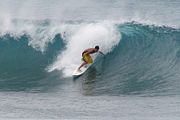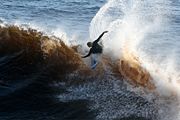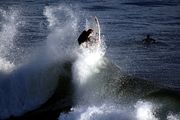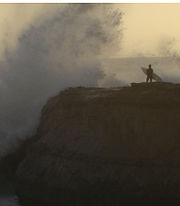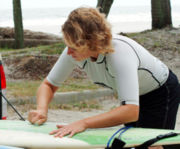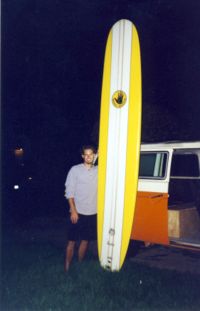Surfing
2008/9 Schools Wikipedia Selection. Related subjects: Recreation
Surfing is a surface water sport in which the participant is carried along the face of a breaking wave, most commonly using a surfboard, although wave-riders may make use of kneeboards, body boards (aka boogie boards), kayaks, surf skis, and their own bodies. Surfing-related sports, such as paddleboarding and sea kayaking do not require waves, and other derivative sports such as kitesurfing and windsurfing rely primarily on wind for power, yet all of these tools may as well be used to ride waves.
Two major subdivisions within contemporary stand-up surfing are reflected by the differences in surfboard design and riding style of longboarding and shortboarding.
In tow-in surfing (most often, but not exclusively, associated with big wave surfing), a surfer is towed into the wave by a motorized water vehicle, such as a jetski, generally because standard paddling is often ineffective when trying to match a large wave's higher speed.
Origin
The first European record of surfing in Hawaii comes from Lieutenant James King,, who completed the journals of Captain James Cook upon Cooks's death in 1779. At the time, surfing had already been an integral part of indigenous Hawaiian culture for generations. Native Hawaiian surfers rode waves lying down, sitting or standing on long, hardwood boards. Surfing is a sport of native Hawaiian life as any major sport is part of western life today, if not more. It permeated Hawaiian society, including religion and myth. Hawaiian chiefs would demonstrate and confirm their authority by the skills they displayed in the surf.
Hydrodynamics
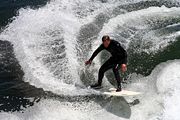
Swell is generated when wind blows consistently over a large area of open water, called the wind's fetch. The size of a swell is determined by the strength of the wind, the length of its fetch and its duration. So, surf tends to be larger and more prevalent on coastlines exposed to large expanses of ocean traversed by intense low pressure systems.
Local wind conditions affect wave quality, since the ridable surface of a wave can become choppy in blustery conditions. Ideal surf conditions include a light to moderate strength "offshore" wind, since this blows into the front of the wave.
The factor which most determines wave shape is the topography of the seabed directly behind and immediately beneath the breaking wave. The contours of the reef or sand bank influence wave shape in two respects. Firstly, the steepness of the incline is proportional to the resulting upthrust. When a swell passes over a sudden steep slope, the force of the upthrust causes the top of the wave to be thrown forward, forming a curtain of water which plunges to the wave trough below. Secondly, the alignment of the contours relative to the swell direction determines the duration of the breaking process. When a swell runs along a slope, it continues to peel for as long as that configuration lasts. When swell wraps into a bay or around an island, the breaking wave gradually diminishes in size, as the wave front becomes stretched by diffraction. For specific surf spots, the state of the ocean tide can play a significant role in the quality of waves or hazards of surfing there. Tidal variations vary greatly among the various global surfing regions, and the effect the tide has on specific spots can vary greatly among the spots within each area. Locations such as Bali, Panama, and Ireland experience 2-3 meter tide fluctuations, whereas in Hawaii the difference between high and low tide is typically less than one meter.
In order to know a surf break one must be sensitive to each of these factors. Each break is different, since the underwater topography of one place is unlike any other. At beach breaks, even the sandbanks change shape from week to week, so it takes commitment to get good waves (a skill dubbed "broceanography" by a few California surfers). That is why surfers have traditionally regarded surfing to be more of a lifestyle than a sport. Nowadays, however, surf forecasting is aided by advances in information technology, whereby mathematical modelling graphically depicts the size and direction of swells moving around the globe.

The regularity of swell varies across the globe and throughout the year. During winter, heavy swells are generated in the mid-latitudes, when the north and south polar fronts shift toward the Equator. The predominantly westerly winds generate swells that advance eastward. So, waves tend to be largest on west coasts during the winter months. However, an endless train of mid-latitude cyclones causes the isobars to become undulated, redirecting swells at regular intervals toward the tropics.
East coasts also receive heavy winter swells when low pressure cells form in the sub-tropics, where their movement is inhibited by slow moving highs. These lows produce a shorter fetch than polar fronts, however they can still generate heavy swells, since their slower movement increases the duration of a particular wind direction. After all, the variables of fetch and duration both influence how long the wind acts over a wave as it travels, since a wave reaching the end of a fetch is effectively the same as the wind dying off.
During summer, heavy swells are generated when cyclones form in the tropics. Tropical cyclones form over warm seas, so their occurrence is influenced by El Niño & La Niña cycles. Their movements are unpredictable. They can even move westward, which is unique for a large scale weather system. In 1979, Tropical Cyclone Kerry wandered for 3 weeks across the Coral Sea and into Queensland, before dissipating.
The quest for perfect surf has given rise to a field of tourism based on the surfing adventure. Yacht charters and surf camps offer surfers access to the high quality surf found in remote, tropical locations, where tradewinds ensure offshore conditions. Since winter swells are generated by mid-latitude cyclones, their regularity coincides with the passage of these lows. So, the swells arrive in pulses, each lasting for a couple of days, with a couple of days between each swell. Since bigger waves break in a different configuration, a rising swell is yet another variable to consider when assessing how to approach a break.
Wave intensity classification
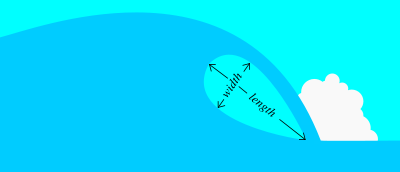
Classification parameters
- Tube shape defined by length to width ratio
- Square: <1:1
- Round: 1-2:1
- Almond: >2:1
- Tube speed defined by angle of peel line
- Fast: 30°
- Medium: 45°
- Slow: 60°
| Fast | Medium | Slow | |
|---|---|---|---|
| Square | The Cobra | Teahupoo | Shark Island |
| Round | Speedies, Gnaraloo | Banzai Pipeline | |
| Almond | Lagundri Bay, Superbank | Jeffreys Bay, Bells Beach | Angourie Point |
Artificial reefs
The value of good surf has even prompted the construction of artificial reefs and sand bars to attract surf tourism. Of course, there is always the risk that one's holiday coincides with a "flat spell". Wave pools aim to solve that problem, by controlling all the elements that go into creating perfect surf, however there are only a handful of wave pools that can simulate good surfing waves, owing primarily to construction and operation costs and potential liability.
The availability of free model data from the NOAA has allowed the creation of several surf forecasting websites.
Surfers and surf culture
Surfers represent a diverse culture based on riding the naturally occurring process of ocean waves. Some people practice surfing as a recreational activity while others demonstrate extreme devotion to the sport by making it the central focus of their lives. Within the United States, surfing culture is most dominant in California and Hawaii. It's culture represents a lifestyle devoted to freedom and self expression. Surfing culture often includes a spirituality associated with being one with nature. Some historical markers of the culture included the woodie, the station wagon used to carry surfers' boards, as well as boardshorts, the long swim suits typically worn while surfing. Today, the modern clothing retailer of Hollister Co. has marketed surfing culture towards mainstrean America. Surfing culture has also played an important role in the development of skateboarding, by the late 50's " sidewalk surfing" had begun to take root. The influence of surfing on skateboarding subculture was evident well into the 80's and still continues on today in a lesser form. However, skateboarding in the 90's became heavily influenceed by urban culture, and has since, for the most part, deviated from its surfing roots.
The sport of surfing has become so popular that it now represents a multi-billion dollar industry. Some people make a career out of surfing by receiving corporate sponsorships, competing in contests, or marketing and selling surf related products, such as equipment and clothing. Other surfers separate themselves from any and all commercialism associated with surfing. These "soul surfers", as they are often called, practice the sport purely for personal enjoyment and many even find a deeper meaning through involving themselves directly with naturally occurring wave patterns and subscribe to ecological philosophies, or ecosophies.
On September 2, 2007, in Brazil, 84 surfers caught the same wave (from Australia, South Africa, Portugal, Britain and the US, to beat the former record of 73 surfers on a wave). But while 300 turned up in Cornwall and Capetown, the Brazilian waxheads won. With only 120 people, surfers in Santos, south-east of Sao Paulo, smashed the South African record.
Maneuvers

Surfing begins with the surfer eyeing a rideable wave on the horizon and then attempting to match its speed (by paddling or sometimes, by tow-in). Once the wave has started to carry the surfer forward, the surfer quickly jumps to his or her feet and proceeds to ride down the face of the wave, generally staying just ahead of the breaking part (white water) of the wave (in a place often referred to as "the pocket" or "the curl"). A common problem for beginners is not even being able to catch the wave in the first place, and one sign of a good surfer is being able to catch a difficult wave that other surfers cannot.
Surfers' skills are tested not only in their ability to control their board in challenging conditions and/or catch and ride challenging waves, but also by their ability to execute various maneuvers such as turning and carving. Some of the common turns have become recognizable tricks such as the "cutback" (turning back toward the breaking part of the wave), the "floater" (riding on the top of the breaking curl of the wave), and "off the lip" (banking off the top of the wave). A newer addition to surfing has been the progression of the "air" where a surfer is able to propel oneself off the wave and re-enter. Some of these maneuvers are now executed to extreme degrees, as with off-the-lips where a surfer over-rotates his turn and re-enters backward, or airs done in the same fashion, recovering either with re-rotation or continuing the over-rotation to come out with his nose forward again.
"Tube riding" is when a surfer maneuvers into a position where the wave curls over the top of him or her, forming a "tube" (or "barrel"), with the rider inside the hollow cylindrical portion of the wave. This difficult and sometimes dangerous procedure is arguably the most coveted and sought after goal in surfing.
"Hanging Ten" and "Hanging Five" are moves usually specific to longboarding. Hanging Ten refers to having both feet on the front end of the board with all ten of the surfer's toes off the edge, also known as noseriding. Hanging Five is having just one foot near the front, and five toes off the edge.
Common terms
- Regular/Natural foot - Right foot on back of board
- Goofy foot - Left foot on back of board
- Take off - the start of a ride
- Drop in - dropping into (engaging) the wave, most often as part of standing up
- Drop in on, cut off, or "burn" - taking off on a wave in front of someone closer to the peak (considered inappropriate)
- Duck dive - pushing the board underwater, nose first, and diving through an oncoming wave instead of riding it
- Snaking/Back-Paddling - paddling around someone to get into the best position for a wave (in essence, stealing it)
- Pop-up - Going from lying on the board to standing, all in one jump
- Bottom turn - the first turn at the bottom of the wave
- Shoulder - the unbroken part of the wave
- Cutback - a turn cutting back toward the breaking part of the wave
- Fade - on take off, aiming toward the breaking part of the wave, before turning sharply and surfing in the direction the wave is breaking towards
- Over the falls - When a surfer falls and the wave carries him in a circular motion with the lip of the wave, also referred to as the "wash cycle", being "pitched over" and being "sucked over" because the wave can suck the surfer off of the bottom and draw him or her "over the falls."
- Pump - an up/down carving movement that generates speed along a wave
- Stall - slowing down by shifting weight to the tail of the board or putting a hand in the water
- Floater - riding up on the top of the breaking part of the wave, and coming down with it
- Hang-five/hang-ten - putting five or ten toes respectively over the nose of a longboard
- Hang Heels - Facing backwards and putting the surfers' heels over the edge of a longboard.
- Re-entry - hitting the lip vertically and re-rentering the wave in quick succession.
- Switch-foot - having equal ability to surf regular foot or goofy foot (i.e. left foot forward or right foot forward) -- like being ambidextrous
- Tube riding/Getting barreled - riding inside the hollow curl of a wave
- Carve - turns (often accentuated)
- Pearl - accidentally driving the nose of the board underwater, generally ending the ride
- Off the Top - a turn on the top of a wave, either sharp or carving
- Snap - a quick, sharp turn off the top of a wave
- Fins-free snap (or "fins out") - a sharp turn where the fins slide off the top of the wave
- Air/Aerial - riding the board briefly into the air above the wave, landing back upon the wave, and continuing to ride.
- Grom/Grommet - young surfer (usually under 15 or so)
Equipment
Surfing can be done on various pieces of equipment, including surfboards, bodyboards, wave skis, kneeboards and surf mat. Surfboards were originally made of solid wood and were generally quite large and heavy (often up to 12 feet long and 100 pounds / 45 kg). Lighter balsa wood surfboards (first made in the late 1940s and early 1950s) were a significant improvement, not only in portability, but also in increasing maneuverability on the wave.
Most modern surfboards are made of polyurethane foam (with one or more wooden strips or "stringers"), fibreglass cloth, and polyester resin. An emerging surf technology is an epoxy surfboard, which are stronger and lighter than traditional fibreglass. Even newer surfboard designs incorporate materials such as carbon fibre and springy 'firewire'.
Equipment used in surfing includes a leash (to stop a surfer's board from washing to shore after a "wipeout", and to prevent it from hitting other surfers), surf wax and/or traction pads (to keep a surfer's feet from slipping off the deck of the board), and "fins" (also known as "skegs") which can either be permanently attached ("glassed-on") or interchangeable. In warmer climates swimsuits, surf trunks or boardshorts are worn, and occasionally rash guards; in cold water surfers can opt to wear wetsuits, boots, hoods, and gloves to protect them against lower water temperatures.
There are many different surfboard sizes, shapes, and designs in use today. Modern longboards, generally 9 to 10 feet in length, are reminiscent of the earliest surfboards, but now benefit from all the modern innovations of surfboard shaping and fin design.
The modern shortboard began its life in the late 1960s evolving up to today's common "thruster" style shortboard, a three fin design, usually around 6 to 7 feet in length.
Midsize boards, often called funboards, provide more maneuverability than a longboard, with more floatation than a shortboard. While many surfers find that funboards live up to their name, providing the best of both surfing modes, others are critical. "It is the happy medium of mediocrity," writes Steven Kotler. "Funboard riders either have nothing left to prove or lack the skills to prove anything."
There are also various niche styles, such as the "Egg", a longboard-style short board, the "Fish", a short and wide board with a split tail and two or four fins, and the "Gun", a long and pointed board specifically designed for big waves.
Dangers
Drowning
Surfing, like all water sports, carries the inherent danger of drowning. Although a surfboard may assist a surfer in staying buoyant, it cannot be relied on for floatation, as it can be separated from the user. The use of a leash, which is attached at the ankle or knee, keeps the surfer connected to the board for convenience but should not be used as a safeguard to prevent drowning. The established rule is that if the surfer cannot handle the water conditions without his or her board then he or she should not go in. Drownings have occurred as a result of leashes becoming caught on reefs holding the surfer underwater. In very large waves such as Waimea or Mavericks being attached to the board may be undesirable as it can be pulled for long distances in the whitewater, holding the surfer underneath the wave. Surfers will often surf in pairs or groups as a safeguard.
Collisions
A large number of injuries, up to 66%, are caused by impact of either a surfboard nose or fins with the surfer's body. Surfboard fins can cause deep lacerations and cuts as well as bruising due to their shape. While these injuries can be minor, they can open the skin to infection from the sea; groups like SAS campaign for cleaner waters to reduce this risk.
There is also a danger of collision from objects under the water surface. These include sand, coral and rocks. Collisions with these objects may cause unconsciousness or even death.
Sealife
Various types of sealife can cause injuries and even fatalities. Depending on the location of the surfing activity, animals such as sharks, stingrays, and jellyfish may be a danger to surfers.
Locals
Local surfers can be violent when it comes to protect their surf break from tourists. In the 70's the locals in Malibu and on Hawaii called Da hui have been known to threaten tourists with physical violence for invading their territory.
Sandbars, Rocks, and Reef
There is a danger to anything that a surfers body can come in contact with. This would include sandbars, rocks, and reef that is in the ocean. These things are dangerous because if a surfer does come into contact with one he or she may be injured very badly because of the impact of the wave.
